Instrument CITROEN DS4 2023 Manual PDF
[x] Cancel search | Manufacturer: CITROEN, Model Year: 2023, Model line: DS4, Model: CITROEN DS4 2023Pages: 296, PDF Size: 9.91 MB
Page 163 of 296

161
Malfunction
In the event of a system fault when
engaging reverse gear, this warning
lamp is displayed in the instrument
panel and/or a message appears
in the screen, accompanied by an
audible signal (short beep).
Contact the dealer network or a
qualified workshop to have the
system checked.
In bad or wintry weather, ensure that the
sensors are not covered with mud, ice or
snow. When reverse gear is engaged, an
audible signal (long beep) indicates that
the sensors may be dirty.
Certain sound sources (motorcycle,
lorry, pneumatic drill, etc.) may trigger
the audible signals of the parking sensor
system.
Reversing camera
This system is a driving aid that does not
replace the need for vigilance on the part
of the driver, who must remain in control of
the vehicle at all times. The green lines represent distances of about
1
and 2 metres beyond the edge of your
vehicle's rear bumper.
The red line represent a distance of about
30 cm beyond the edge of your vehicle's rear
b u m p e r.
The lines displayed in the screen do not
allow the position of the vehicle to be
determined relative to tall obstacles (for
example: vehicles nearby).
Some deformation of the image is normal.
High pressure jet wash
When washing your vehicle, keep the
end of the high pressure lance at least
12 inches (30 cm) away from the camera
lens.
Clean the camera lens regularly using a
soft cloth.
The reversing camera function may be
supplemented with parking sensors.
The reversing camera is activated automatically
when reverse gear is engaged.
The colour visual feedback is done on the
touch screen. The blue lines represent the general direction
of the vehicle.
The blue cur ved lines represent the maximum
turning circle.
06
Driving
Page 168 of 296

166
Fuel
Tank capacity: approximately 60 litres.
Low fuel level
When the low fuel level is reached
in the tank, this warning lamp
comes on in the instrument panel,
accompanied by an audible warning
and the display of an alert message.
When it first comes on, about
6 litres of fuel is left in the tank.
Until sufficient fuel has been added, every time
the ignition is switched on, this warning lamp
appears, accompanied by an audible signal
and an alert message. When driving, this
audible signal and alert message are repeated
with increasing frequency, as the level drops
towards 0 .
You must refuel as soon as possible to avoid
running out of fuel.
If you run out of fuel (Diesel), refer to the
corresponding section.
Refuelling
Additions of fuel must be of at least 5 litres, in
order to be registered by the fuel gauge. With Stop & Start, never refuel with the
system in STOP mode; you must switch
off the ignition with the key, or the START/
STOP button if your vehicle has Keyless
Entry and Starting.
Opening the filler cap may create a noise
caused by an inrush of air. This vacuum is
entirely normal, resulting from the sealing of the
fuel system.
F
P
ress this button until the automatic
opening of the fuel flap is heard.
This control remains active for a few minutes after switching off the ignition. If necessary,
switch the ignition on again to reactivate it.
F
T
ake care to select the pump that delivers
the correct type of fuel for your vehicle. F
I
ntroduce the nozzle so as to push in the
metal non-return flap.
F
M
ake sure that the nozzle is pushed in as
far as possible before starting to refuel (risk
of blowback).
F
H
old it in this position throughout the filling
operation.
F
P
ush the fuel flap to close it.
If you are filling your tank to the top, do not
persist after the third cut- off; this could
cause your vehicle to malfunction.
Your vehicle is fitted with a catalytic converter,
which helps to reduce the level of harmful
emissions in the exhaust gases.
For petrol engines, you must use unleaded
fuel.
The filler neck is narrower, allowing only
unleaded petrol nozzles to be introduced.
07
Practical information
Page 181 of 296
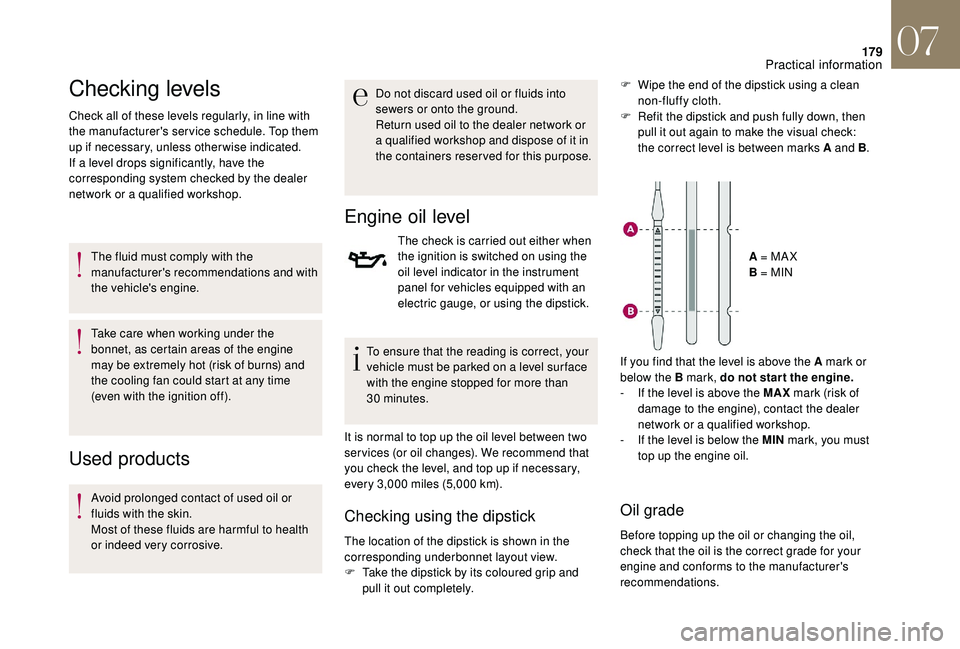
179
Checking levels
Check all of these levels regularly, in line with
the manufacturer's service schedule. Top them
up if necessary, unless other wise indicated.
If a level drops significantly, have the
corresponding system checked by the dealer
network or a qualified workshop.The fluid must comply with the
manufacturer's recommendations and with
the vehicle's engine.
Take care when working under the
bonnet, as certain areas of the engine
may be extremely hot (risk of burns) and
the cooling fan could start at any time
(even
with the ignition off).
Used products
Avoid prolonged contact of used oil or
fluids with the skin.
Most of these fluids are harmful to health
or indeed very corrosive. Do not discard used oil or fluids into
sewers or onto the ground.
Return used oil to the dealer network or
a qualified workshop and dispose of it in
the containers reser ved for this purpose.
Engine oil level
The check is carried out either when
the ignition is switched on using the
oil level indicator in the instrument
panel for vehicles equipped with an
electric gauge, or using the dipstick.
To ensure that the reading is correct, your
vehicle must be parked on a level sur face
with the engine stopped for more than
30
minutes.
It is normal to top up the oil level between two
ser vices (or oil changes). We recommend that
you check the level, and top up if necessary,
every 3,000 miles (5,000 km).
Checking using the dipstick
The location of the dipstick is shown in the
corresponding underbonnet layout view.
F
T
ake the dipstick by its coloured grip and
pull it out completely. A = MA X
B = MIN
If you find that the level is above the A mark or
below the B mark, do not star t the engine.
-
I
f the level is above the MAX
mark (risk of
damage to the engine), contact the dealer
network or a qualified workshop.
-
I
f the level is below the MIN
mark, you must
top up the engine oil.
Oil grade
Before topping up the oil or changing the oil,
check that the oil is the correct grade for your
engine and conforms to the manufacturer's
recommendations. F
W
ipe the end of the dipstick using a clean
non-fluffy cloth.
F
R
efit the dipstick and push fully down, then
pull it out again to make the visual check:
the correct level is between marks A and B .
07
Practical information
Page 182 of 296
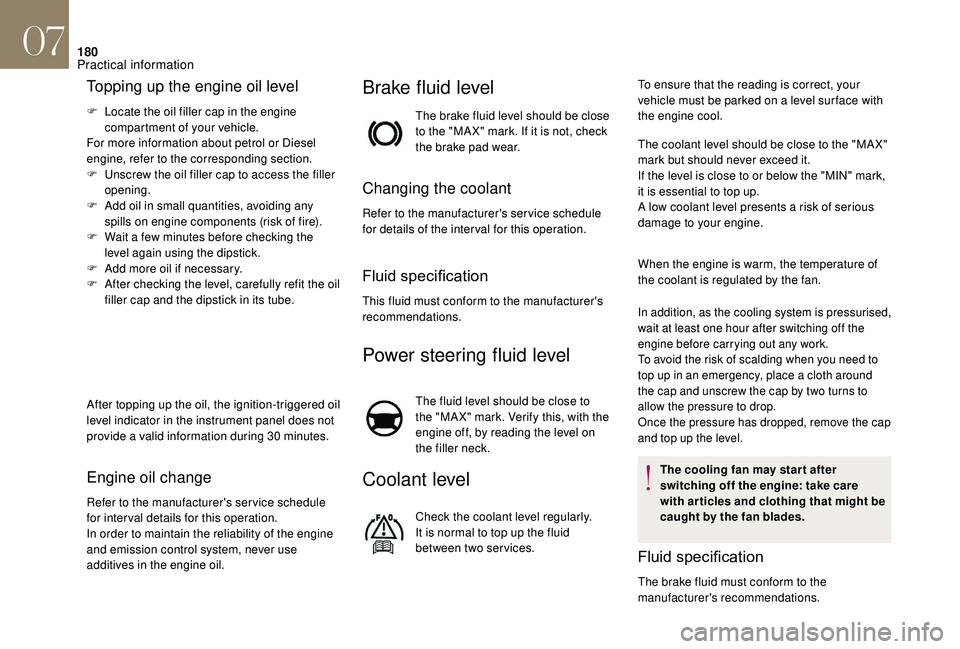
180
Topping up the engine oil level
F Locate the oil filler cap in the engine compartment of your vehicle.
For more information about petrol or Diesel
engine, refer to the corresponding section.
F
U
nscrew the oil filler cap to access the filler
opening.
F
A
dd oil in small quantities, avoiding any
spills on engine components (risk of fire).
F
W
ait a few minutes before checking the
level again using the dipstick.
F
A
dd more oil if necessary.
F
A
fter checking the level, carefully refit the oil
filler cap and the dipstick in its tube.
After topping up the oil, the ignition-triggered oil
level indicator in the instrument panel does not
provide a valid information during 30 minutes.
Engine oil change
Refer to the manufacturer's service schedule
for inter val details for this operation.
In order to maintain the reliability of the engine
and emission control system, never use
additives in the engine oil.
Brake fluid level
The brake fluid level should be close
to the "MA X" mark. If it is not, check
the brake pad wear.
Changing the coolant
Refer to the manufacturer's service schedule
for details of the inter val for this operation.
Fluid specification
This fluid must conform to the manufacturer's
recommendations.
Power steering fluid level
The fluid level should be close to
the "MA X" mark. Verify this, with the
engine off, by reading the level on
the filler neck.
Coolant level
Check the coolant level regularly.
It is normal to top up the fluid
between two services. To ensure that the reading is correct, your
vehicle must be parked on a level sur face with
the engine cool.
The coolant level should be close to the "MA X"
mark but should never exceed it.
If the level is close to or below the "MIN" mark,
it is essential to top up.
A low coolant level presents a risk of serious
damage to your engine.
When the engine is warm, the temperature of
the coolant is regulated by the fan.
In addition, as the cooling system is pressurised,
wait at least one hour after switching off the
engine before carrying out any work.
To avoid the risk of scalding when you need to
top up in an emergency, place a cloth around
the cap and unscrew the cap by two turns to
allow the pressure to drop.
Once the pressure has dropped, remove the cap
and top up the level.
The cooling fan may star t after
switching off the engine: take care
with articles and clothing that might be
caught by the fan blades.
Fluid specification
The brake fluid must conform to the
manufacturer's recommendations.
07
Practical information
Page 183 of 296

181
Screenwash/headlamp wash
level
To check the level or top up the fluid
on vehicles fitted with headlamp
washers, immobilise the vehicle and
switch off the engine.
F
O
pen the bonnet and secure it with the stay.
F
O
pen the screenwash reservoir filler cap.
F
T
ake and pinch the level gauge to block its
breather.
F
R
emove the gauge completely from the
reser voir to read the level in the transparent
section.
F
T
op up if necessary.
F
R
efit the filler cap to the reser voir and close
the bonnet.
Fluid specifications
For optimum cleaning and to avoid freezing,
this fluid must not be topped up or replaced
with plain water.
In wintry conditions, using an ethyl alcohol or
methanol based fluid is recommended.
Diesel fuel additive level
(Diesel with particle filter)
According to your version of instrument panel,
the additive reser voir low level is indicated by:
Topping up
This additive must be topped up without
delay by a member of the dealer network or a
qualified workshop. -
f
ixed illumination of the
particle filter warning lamp,
accompanied by an audible
signal and a message that the
particle filter additive level is too
low,
or
-
f
ixed illumination of the Ser vice
warning lamp, accompanied
by an audible signal and a
message that the particle filter
additive level is too low.
Checks
Unless otherwise indicated, check these
components in accordance with the
manufacturer's service schedule and according
to your engine. .
Otherwise, have them checked by the dealer
network or a qualified workshop.
12 V battery
The battery does not require any
maintenance.
However, check regularly that the
terminals are correctly tightened
(versions without quick release terminals)
and that the connections are clean.
For more information on the precautions
to take before starting work on the 12 V
battery , refer to the corresponding
section.
Versions equipped with Stop & Start are
fitted with a 12 V lead-acid battery of
specific technology and specification.
Its replacement should be carried out
only in the dealer network or a qualified
workshop.
07
Practical information
Page 184 of 296
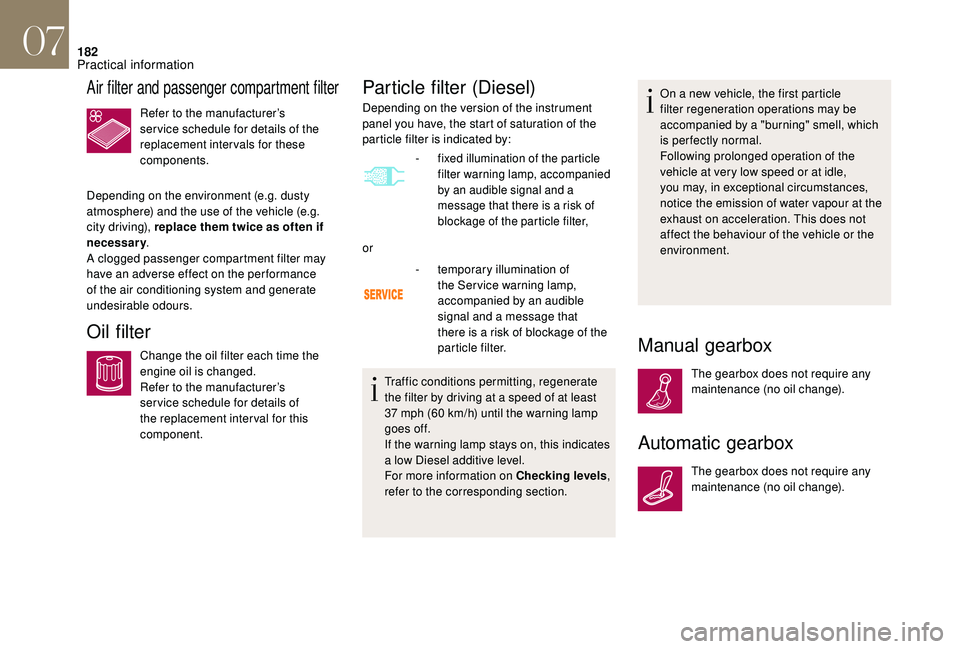
182
Air filter and passenger compartment filter
Refer to the manufacturer’s
ser vice schedule for details of the
replacement intervals for these
components.
Depending on the environment (e.g. dusty
atmosphere) and the use of the vehicle (e.g.
city driving), replace them twice as often if
necessary .
A clogged passenger compartment filter may
have an adverse effect on the per formance
of the air conditioning system and generate
undesirable odours.
Oil filter
Change the oil filter each time the
engine oil is changed.
Refer to the manufacturer’s
ser vice schedule for details of
the replacement inter val for this
component.
Particle filter (Diesel)
Depending on the version of the instrument
panel you have, the start of saturation of the
particle filter is indicated by:
Manual gearbox
The gearbox does not require any
maintenance (no oil change).
Automatic gearbox
The gearbox does not require any
maintenance (no oil change).
- fixed illumination of the particle filter warning lamp, accompanied
by an audible signal and a
message that there is a risk of
blockage of the particle filter,
or
-
t
emporary illumination of
the Ser vice warning lamp,
accompanied by an audible
signal and a message that
there is a risk of blockage of the
particle filter. On a new vehicle, the first particle
filter regeneration operations may be
accompanied by a "burning" smell, which
is per fectly normal.
Following prolonged operation of the
vehicle at very low speed or at idle,
you may, in exceptional circumstances,
notice the emission of water vapour at the
exhaust on acceleration. This does not
affect the behaviour of the vehicle or the
environment.
Traffic conditions permitting, regenerate
the filter by driving at a speed of at least
37 mph (60 km/h) until the warning lamp
goes off.
If the warning lamp stays on, this indicates
a low Diesel additive level.
For more information on Checking levels ,
refer to the corresponding section.
07
Practical information
Page 197 of 296

195
Tyre under-inflation detection
The spare wheel is not fitted with a sensor.
The punctured tyre must be repaired
or replaced by a member of the dealer
network or a qualified workshop.
Removing a wheel
Parking the vehicle
Immobilise the vehicle where it does not
block traffic: the ground must be level,
stable and non-slippery.
Apply the parking brake unless it has been
programmed to automatic mode, switch
off the ignition and engage first gear
(position P for the automatic gearbox) to
lock the wheels.
Check that the parking brake warning
lamps in the instrument panel come on.
The occupants must get out of the vehicle
and wait where they are safe.
If necessary, place a chock under the
wheel diagonally opposite the wheel to be
changed.
Never go underneath a vehicle raised
using a jack; use an axle stand.List of operations
F Remove the bolt cover from each of the bolts using the tool 3 (according to
equipment).
F
F
it the security socket 4 on the wheelbrace
1 to slacken the security bolt.
F
S
lacken the other bolts using the
wheelbrace 1 o n l y.
08
In the event of a breakdown
Page 226 of 296
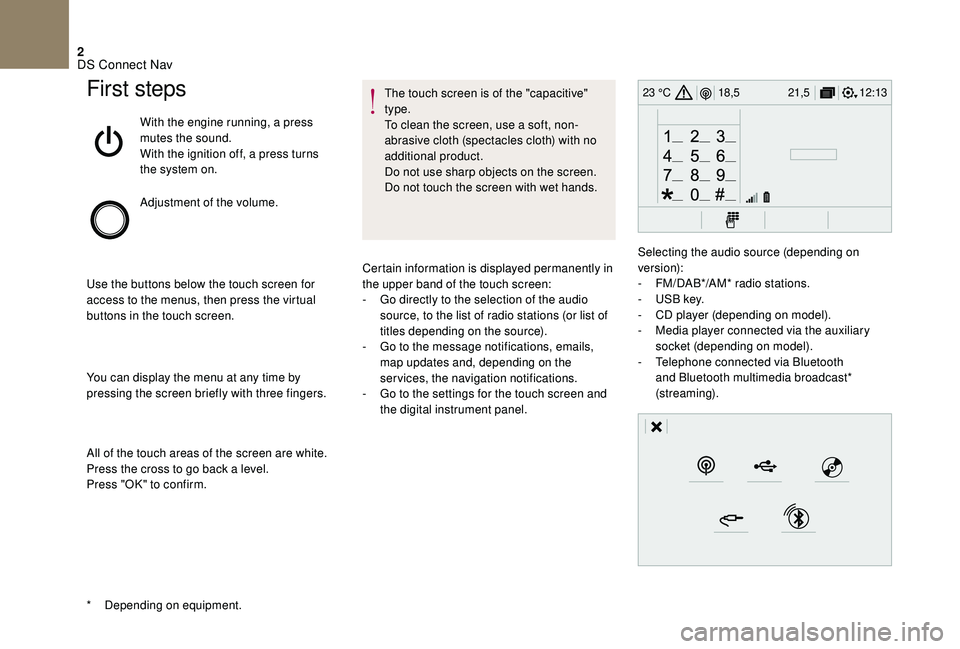
2
12:13
18,5 21,5
23 °CFirst steps
With the engine running, a press
mutes the sound.
With the ignition off, a press turns
the system on.
Adjustment of the volume.
Use the buttons below the touch screen for
access to the menus, then press the virtual
buttons in the touch screen.
You can display the menu at any time by
pressing the screen briefly with three fingers.
All of the touch areas of the screen are white.
Press the cross to go back a level.
Press "OK" to confirm. The touch screen is of the "capacitive"
type.
To clean the screen, use a soft, non-
abrasive cloth (spectacles cloth) with no
additional product.
Do not use sharp objects on the screen.
Do not touch the screen with wet hands.
*
D
epending on equipment. Certain information is displayed permanently in
the upper band of the touch screen:
-
G
o directly to the selection of the audio
source, to the list of radio stations (or list of
titles depending on the source).
-
G
o to the message notifications, emails,
map updates and, depending on the
services, the navigation notifications.
-
G
o to the settings for the touch screen and
the digital instrument panel. Selecting the audio source (depending on
version):
-
F
M/DAB*/AM* radio stations.
-
U
SB key.
-
C
D player (depending on model).
-
M
edia player connected via the auxiliary
socket (depending on model).
-
T
elephone connected via Bluetooth
and Bluetooth multimedia broadcast*
(streaming).
DS Connect Nav
Page 260 of 296
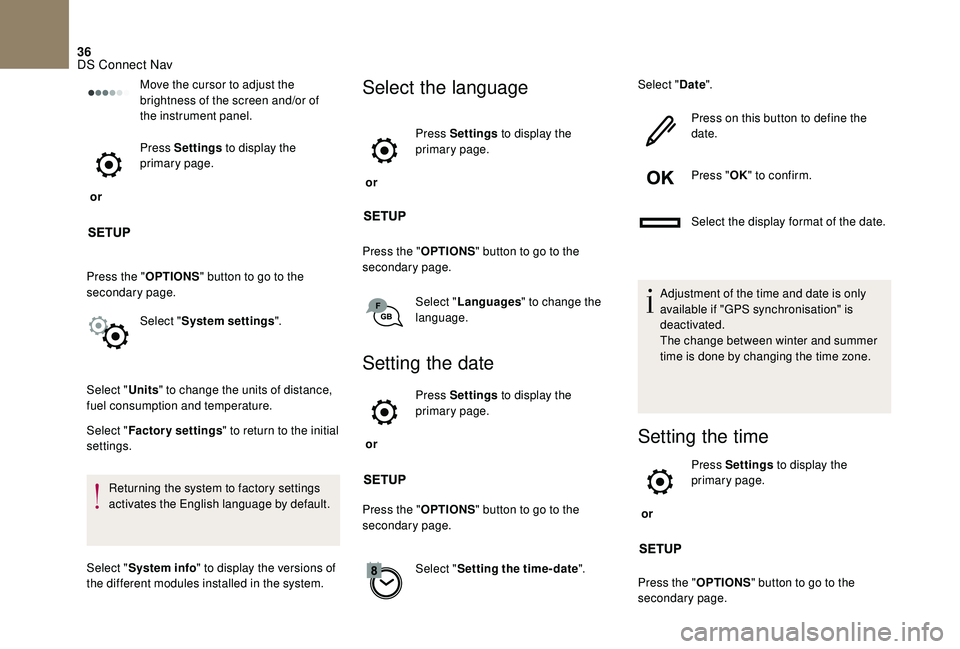
36
Move the cursor to adjust the
brightness of the screen and/or of
the instrument panel.
or Press Settings
to display the
primary page.
Press the " OPTIONS" button to go to the
secondary page.
Select "System settings ".
Select " Units" to change the units of distance,
fuel consumption and temperature.
Select " Factory settings " to return to the initial
settings.
Returning the system to factory settings
activates the English language by default.
Select " System info " to display the versions of
the different modules installed in the system.Select the language
or Press Settings
to display the
primary page.
Press the " OPTIONS" button to go to the
secondary page.
Select "Languages " to change the
language.
Setting the date
or Press Settings
to display the
primary page.
Press the " OPTIONS" button to go to the
secondary page.
Select "Setting the time- date". Select "
Date".
Press on this button to define the
date.
Press " OK" to confirm.
Select the display format of the date.
Adjustment of the time and date is only
available if "GPS synchronisation" is
deactivated.
The change between winter and summer
time is done by changing the time zone.Setting the time
or Press Settings
to display the
primary page.
Press the " OPTIONS" button to go to the
secondary page.
DS Connect Nav
Page 289 of 296
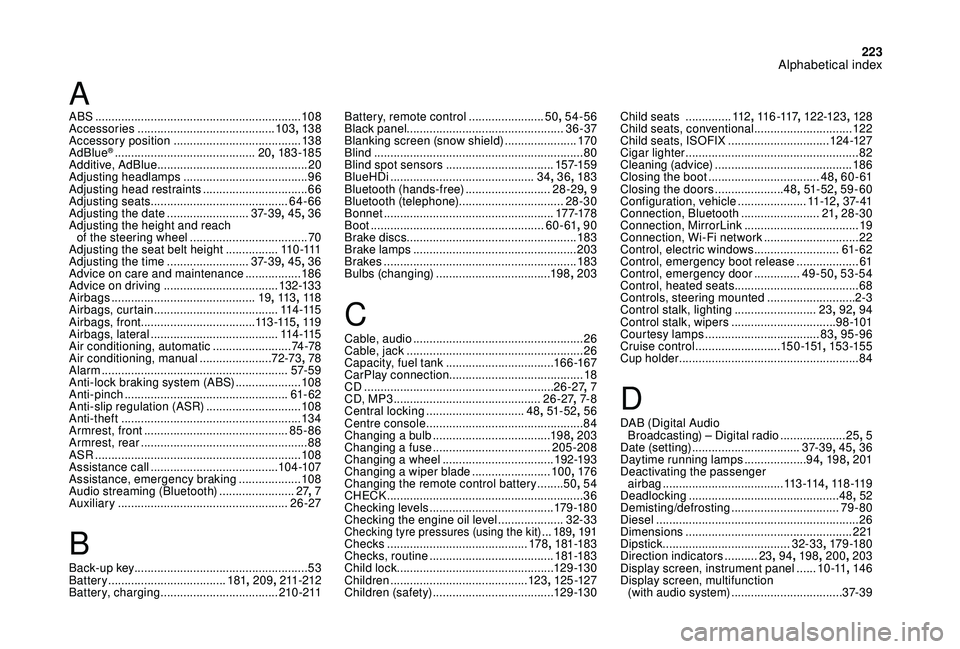
223
ABS ...............................................................108
Accessories .......................................... 103, 13 8
Accessory position
....................................... 13 8
AdBlue
® ........................................... 20, 183 -185
Additive, AdBlue .............................................. 20
Adjusting headlamps
...................................... 96
Adjusting head restraints
................................ 66
Adjusting seats
.......................................... 64-66
Adjusting the date
......................... 37- 3 9, 45, 36
Adjusting the height and reach of the steering wheel
.................................... 70
Adjusting the seat belt height
................ 11
0 -111
Adjusting the time
......................... 37- 3 9, 45, 36
Advice on care and maintenance
.................18 6
Advice on driving
................................... 132-13 3
Airbags
...............................
.............19, 113 , 11 8
Airbags, curtain
...................................... 114 -115
Airbags, front ................................... 113 -115, 11 9
Airbags, lateral
....................................... 114 -115
Air conditioning, automatic
........................74 -7 8
Air conditioning, manual
...................... 7
2-73, 78
Alarm
......................................................... 57- 5 9
Anti-lock braking system (ABS)
....................108
Anti-pinch
.................................................. 61
- 62
Anti-slip regulation (ASR)
............................. 108
Anti-theft
....................................................... 13 4
Armrest, front
............................................ 85-86
Armrest, rear
...............................
....................88
ASR
........
....................................................... 108
Assistance call
...............................
........104 -107
Assistance, emergency braking
...................108
Audio streaming (Bluetooth)
.......................27, 7
Auxiliary
.................................................... 26-27
B
Back-up key..................................................... 53
Battery .................................... 181, 209 , 211-212
Battery, charging
.................................... 210 -211Battery, remote control
.......................
50, 54-56
Black panel ................................................ 36 -37
Blanking screen (snow shield)
......................
170
Blind
..............................
..................................
80
Blind spot sensors
.................................
157-159
BlueHDi
............................................
34, 36 , 183
Bluetooth (hands-free)
.......................... 2
8-29
, 9
Bluetooth (telephone)
................................ 28
-30
Bonnet
....................................................
17 7-178
Boot
.....................................................
60 - 61, 90
Brake discs
....................................................
183
Brake lamps
...............................
...................
203
Brakes
...........................................................
183
Bulbs (changing)
...................................
198, 203
C
Cable, audio .................................................... 26
Cable, jack ...................................................... 26
Capacity, fuel tank
................................. 166 -167
CarPlay connection ......................................... 18
CD
.......................................................... 26-27, 7
CD, MP3
............................................. 26-27, 7- 8
Central locking
.............................. 48
, 51- 5 2, 56
Centre console
................................................ 84
Changing a bulb
.................................... 19
8, 203
Changing a fuse
.................................... 20
5-208
Changing a wheel
.................................. 19
2-193
Changing a wiper blade
........................ 10
0, 176
Changing the remote control battery
........50, 54
CHECK
................
............................................ 36
Checking levels
...................................... 179 -18 0
Checking the engine oil level
....................32-33
Checking tyre pressures (using the kit) ...18 9, 191Checks ........................................... 178, 181-183
Checks, routine ...................................... 181-183
Child lock
................................................ 12 9 -13 0
Children
.......................................... 123, 125 -127
Children (safety)
..................................... 12 9 -13 0
A
Child seats ..............11 2, 11 6 -117 , 12 2-123 , 128
Child seats, conventional ..............................12 2
Child seats, ISOFIX
...............................124 -127
Cigar lighter
..................................................... 82
Cleaning (advice)
.......................................... 18 6
Closing the boot
.................................. 48
, 60 - 61
Closing the doors
.....................48, 51- 5 2, 59-60
Configuration, vehicle
..................... 11
-12, 37- 41
Connection, Bluetooth
........................ 21,
28-30
Connection, MirrorLink
...................................19
Connection, Wi-Fi network
.............................22
Control, electric windows
..........................61- 62
Control, emergency boot release
...................61
Control, emergency door
.............. 49
-50, 53-54
Control, heated seats
...................................... 68
Controls, steering mounted
...........................2-3
Control stalk, lighting
.........................23, 92 , 94
Control stalk, wipers
................................9
8 -101
Courtesy lamps
................................... 83, 95-96
Cruise control
.......................... 15 0 -151, 15 3 -15 5
Cup holder
....................................................... 84
D
DAB (Digital Audio
Broadcasting) – Digital radio ....................25, 5
Date (setting)
................................. 37- 3 9, 45, 36
Daytime running lamps
...................94, 198 , 201
Deactivating the passenger airbag
..................................... 113 -114, 11 8 -11 9
Deadlocking
.............................................. 48, 52
Demisting/defrosting
.................................79-80
Diesel
.............................................................. 26
Dimensions .............................. .....................221
Dipstick
................
.......................32-33, 179 -18 0
Direction indicators
..........23, 94 , 198 , 200 , 203
Display screen, instrument panel
......1 0 -11 , 14 6
Display screen, multifunction (with audio system)
.................................. 3
7- 3 9
Alphabetical index